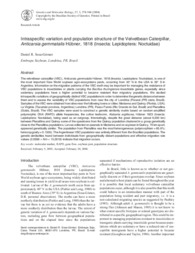Intraspecific variation and population structure of the velvetbean caterpillar, Anticarsia gemmatalis Hübner, 1818 (Insecta: Lepidoptera: Noctuidae).
Intraspecific variation and population structure of the velvetbean caterpillar, Anticarsia gemmatalis Hübner, 1818 (Insecta: Lepidoptera: Noctuidae).
Autoria: SOSA-GOMEZ, D.R.
Resumo: The velvetbean caterpillar (VBC), Anticarsia gemmatalis Hübner, 1818 (Insecta: Lepidoptera: Noctuidae), is one of the most important New World soybean agro-ecosystems pests, occurring from 40° N in the USA to 39° S in Argentina. Information on the migration patterns of the VBC moth may be important for managing the resistance of VBC populations to insecticides or plants carrying the Bacillus thuringiensis insecticide genes, especially since sedentary populations have a higher potential to became resistant than migratory populations. We studied intraspecific variations of geographically distinct VBC populations in order to determine the genetic distance between them and to assess the variability of VBC populations from near the city of Londrina (Paraná (PR) state, Brazil). Samples of the VBC were obtained from sites near the following towns or cities: Marianna and Quincy (Florida, USA); La Virginia (Tucumán province, Argentina); Londrina (PR), Passo Fundo (Rio Grande do Sul, Brazil) and Planaltina (Goiás, Brazil). The VBC samples were used to construct a genetic similarity matrix based on random amplified polymorphic DNA (RAPD) allele frequencies, the cotton leafworm, Alabama argillacea, Hübner 1823 (Insecta: Lepidoptera: Noctuidae), being used as an outgroup. Interestingly, despite the great distance (about 6,500 km) between Planaltina and Quincy some of the specimens from the Quincy population clustered in a group genetically close to the Planaltina populations. Larvae collected on peanuts in Marianna and on soybean in Quincy, 70 km apart, appeared genetically similar. The population from Planaltina was the most heterogeneous (polymorphism = 85.6%; heterozygosity = 0.1505). The Argentinean VBC population was entirely different from the Brazilian populations. The genetic similarities found between individuals from geographically distant populations and effective migration rate values (2.0566 > Nm < 15.2618) indicate that migration occurs.
Ano de publicação: 2004
Tipo de publicação: Artigo de periódico
Unidade: Embrapa Soja
Palavras-chave: Soja
Observações
1 - Por padrão são exibidas publicações dos últimos 20 anos. Para encontrar publicações mais antigas, configure o filtro ano de publicação, colocando o ano a partir do qual você deseja encontrar publicações. O filtro está na coluna da esquerda na busca acima.
2 - Para ler algumas publicações da Embrapa (apenas as que estão em formato ePub), é necessário ter, no celular ou computador, um desses softwares gratuitos. Sistemas Android: Google Play Livros; IOS: iBooks; Windows e Linux: software Calibre.
Acesse outras publicações
Acesse a Base de Dados da Pesquisa Agropecuária (BDPA) para consultar o acervo completo das bibliotecas da Embrapa.

